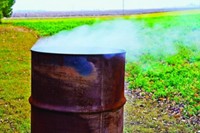Advertisement
Grab your lab coat. Let's get started
Welcome!
Welcome!
Create an account below to get 6 C&EN articles per month, receive newsletters and more - all free.
It seems this is your first time logging in online. Please enter the following information to continue.
As an ACS member you automatically get access to this site. All we need is few more details to create your reading experience.
Not you? Sign in with a different account.
Not you? Sign in with a different account.
ERROR 1
ERROR 1
ERROR 2
ERROR 2
ERROR 2
ERROR 2
ERROR 2
Password and Confirm password must match.
If you have an ACS member number, please enter it here so we can link this account to your membership. (optional)
ERROR 2
ACS values your privacy. By submitting your information, you are gaining access to C&EN and subscribing to our weekly newsletter. We use the information you provide to make your reading experience better, and we will never sell your data to third party members.
Environment
Dioxins, Assessed At Last
Health Effects: Agency says current exposures are not a health risk
by Cheryl Hogue
February 17, 2012

Current exposure to toxic dioxins over a person’s lifetime doesn’t pose a significant health risk, the Environmental Protection Agency concludes in a long-awaited scientific assessment released today.
The agency’s report, which took more than 20 years to complete, sets a safe daily dose of 0.0007 nanograms of 2,3,7,8-tetrachlorodibenzo-p-dioxin (TCDD) per kilogram of body weight. This limit is based on a study finding adverse reproductive effects in men exposed to the chemical as boys and a study finding hormonal effects in infants born to mothers who were exposed to the substance. TCDD is the most potent form of a family of chemicals commonly called dioxins. It includes other chlorinated dioxins and furans and PCBs.
TCDD is an unintentional by-product of the burning of wastes and of manufacturing processes involving chlorine, including the production of vinyl chloride products. Data in EPA’s annual toxics release inventory indicate that industry has slashed its releases of dioxins in the past two decades (C&EN, Feb. 6, page 26). Backyard burning of waste is considered the major source of dioxins in the U.S. today. Dioxins are pervasive in the food supply; they are found in meat, poultry, dairy products, fish, and eggs.
The document examines health effects other than cancer from exposure to TCDD. They include chloracne, a severe skin disease producing acne-like lesions; developmental and reproductive effects, damage to the immune system; hormonal disruption; and, possibly, mild liver damage.
The assessment, which EPA launched in 1991 as an update to a 1985 document outlining the cancer risks of TCDD, has faced many delays and tough challenges from industry, including chemical manufacturers.
“After 21 years in the making, the dioxin assessment is in the hands of the American people,” says Paul T. Anastas, EPA’s top scientist. The release of the assessment came on Anastas’ last day at the agency. He is returning to academic life at Yale University (C&EN, Jan. 16, page 9).
“I quite honestly never thought this report would ever see the light of day” given the years of delays, says Lois Marie Gibbs, executive director of the Center for Health, Environment & Justice, an environmental group that has focused on dioxin issues for years.
“The American people won a major victory against the chemical industry, who has been working behind closed doors for decades to hide and distort the truth about the dangers of dioxin,” Gibbs says.
The assessment will affect the degree—and cost—of cleanups of dioxin-polluted sites. It “will serve as the cornerstone of the agency’s initiatives to protect public health from chemical contaminants and provide the necessary guidance to states and public health agencies to minimize dioxin exposure,” says Olga Naidenko, a senior scientist with the Environmental Working Group, an activist group.
The American Chemistry Council, an association of chemical manufacturers, has invested much time and energy in influencing EPA’s TCDD assessment. It calls the reassessment “flawed.”
In a statement, ACC says, “It is not clear why the agency set a dioxin level that is three times more stringent than other countries and the World Health Organization if the EPA contends that current levels of dioxin do not pose a health concern.” The industry group also criticized the agency for releasing the analysis of TCDD’s health effects other than cancer separately from the cancer assessment.
EPA’s two-decade effort to assess TCDD’s hazard has been beset by delays. For instance, the agency sent its 2003 draft version of the assessment to the National Academy of Sciences for review. NAS took three years to complete a report that said EPA may have overstated TCDD’s cancer risks and advised the agency to rework its assessment. Most recently, EPA missed a deadline to finish this part of the assessment by the end of 2011, a date that had been moved back from the end of 2010 by EPA Administrator Lisa P. Jackson in 2009.
Throughout the years, polluting industries—including chemical companies—have pushed back against EPA’s efforts to assess TCDD’s health hazards and strongly criticized the agency’s science efforts. Community and public health groups have maintained pressure on the agency to finish the document.
Even with the release of the document, the TCDD assessment saga isn’t over. EPA is still working on a second document describing the cancer risks of TCDD. The chemical is classified as a known human carcinogen. The science around the carcinogenicity of TCDD is complicated. Industry has strongly argued—and got some support in the NAS reviews—that some low doses of TCDD do not cause cancer.
Two months ago, ACC asked the agency to delay release of the noncancer assessment until EPA finishes the document examining the cancer hazards of TCDD.





Join the conversation
Contact the reporter
Submit a Letter to the Editor for publication
Engage with us on Twitter